Aardonyx Guide:
Aardonyx was an early dinosaur that lived in South Africa about 200 million years ago.
Aardonyx was an early dinosaur that lived in South Africa about 200 million years ago.
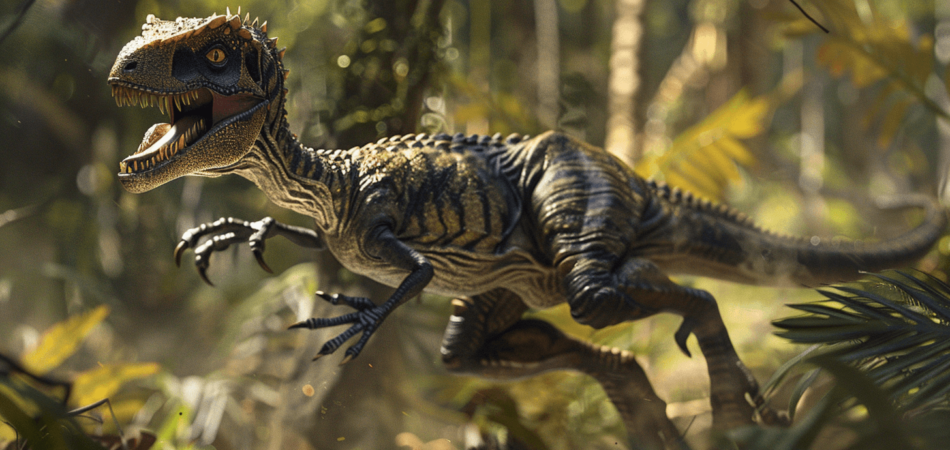
The Velociraptor, belonging to the Dromaeosauridae family, was a standout dinosaur of the Late Cretaceous epoch. It’s renowned for its sickle-shaped claw and evidence of feathers, challenging our classic image of dinosaurs. With a long skull, equipped with sharp, curved teeth, and a body designed for speed and agility, it was a predator to be reckoned with. Studies suggest it hunted in packs, used its acute vision and sensitive hearing to track prey, and had a varied diet. Velociraptors adapted to arid environments, thriving in Asia’s challenging landscapes. This small but fearsome dinosaur continues to fascinate, revealing more secrets beneath the surface.

Velociraptor, a member of the Dromaeosauridae family, is classified under the genus Velociraptor with its primary species being V. mongoliensis and a second known as V. osmolskae. This dinosaur, hailing from the Late Cretaceous epoch, about 75-71 million years ago, has captivated the imaginations of many and remains a subject of fascination in natural history museums worldwide. Originating from what is now Mongolia, the discovery of Velociraptor fossils in the Djadochta Formation and extending to the Bayan Mandahu Formation in China, underscores its historical presence in Eastern Asia.
Velociraptor is often celebrated for its distinctive physical characteristics, particularly its sickle-shaped claw, which it shares with other members of the Dromaeosauridae family. This feature, alongside the fossil evidence suggesting the presence of feathers, paints a picture of a highly specialized theropod that walked the earth millions of years ago. The dinosaur’s evolutionary journey is especially significant, as it provides insights into the shift from dinosaurs to modern-day birds, a topic of ongoing research and debate among paleontologists.
The inclusion of Velociraptor in popular culture, especially in films and literature, has without a doubt contributed to its iconic status. However, the meticulous work of paleontologists, studying fossils and utilizing modern technology to unravel the mysteries of these ancient creatures, that brings us closer to understanding their place in natural history. Therefore, Velociraptor continues to be a key exhibit in natural history museums, offering a window into the past and the evolutionary lineage of theropods.
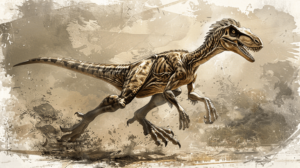
Having explored the taxonomic classification and evolutionary significance of Velociraptor, we now turn our attention to its anatomical features, highlighting the physical traits that distinguished this predator in its Late Cretaceous environment. Central to the Velociraptor’s anatomical description is its infamous sickle-shaped claw, a feature that set it apart as a fearsome hunter. This claw, found on each of the dinosaur’s hind feet, was not merely for show. Instead, it was a highly evolved stabbing weapon, lifted while the creature walked to keep it sharp for quick, lethal attacks on its prey.
The discovery of quill knobs on Velociraptor’s forearm fossils provided groundbreaking evidence of feathers, fundamentally altering our understanding of this creature. These feathers may have served multiple purposes, including display, nest protection, and possibly aiding in running uphill, offering a glimpse into the complex behaviors of this predator. The presence of feathers also supports the theory of a close evolutionary relationship between certain dinosaurs and modern birds.
Velociraptor’s mouth was filled with 13 to 15 sharply curved teeth, each edge lined with strong serrations. These teeth were perfectly adapted for catching and holding onto struggling prey, hinting at a diet that required both power and precision. The combination of sharp teeth, a formidable foot claw, and possibly hunting in packs made Velociraptor an apex predator of its time, capable of taking down prey efficiently and effectively.
This anatomical description of Velociraptor, from its feathers to its fearsome claws, paints a vivid picture of a creature perfectly adapted to its role at the top of the Late Cretaceous food chain.
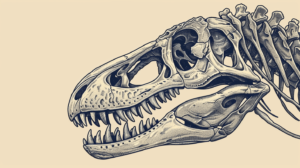
A long skull measuring up to 9.8 inches and an upturned snout are among the defining features that made Velociraptor a remarkably efficient predator. The unique skull characteristics of this dinosaur not only contributed to its iconic appearance but also played a vital role in its hunting and feeding habits. With 26-28 serrated teeth on each side of its mouth, Velociraptor had the tools necessary for catching and consuming fast-moving prey. These serrated teeth, designed for gripping and tearing, were a confirmation of its predatory behavior.
Furthermore, the skull of Velociraptor showcased an up-curved and concave upper jaw, paired with a convex lower jaw. This distinct combination allowed for a powerful bite, essential for subduing prey. The concave jaw helped in holding the prey firmly, while the convex jaw facilitated slicing through flesh with ease. This efficient mouth structure points to Velociraptor’s adaptation towards being a swift and agile predator, capable of executing precise attacks on its prey.
The skull length and the specific curvature of the jaws contributed significantly to Velociraptor’s success in its environment. As a predator, it relied on its agility and the sharpness of its teeth to hunt and feed on small to medium-sized prey. The skull characteristics, from the serrated teeth to the up-curved and concave upper jaw, highlight Velociraptor’s role as a formidable hunter. These features ensured that Velociraptor remained an agile predator, adept at moving through its surroundings and exploiting opportunities to feed and survive.
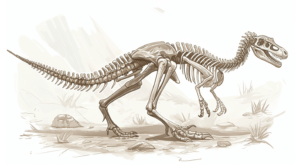
Beyond its formidable skull, the Velociraptor’s postcranial skeleton reveals adaptations that frequently underscored its reputation as a swift and agile predator. The intricacies of its skeletal structure, particularly the bony projections and ossified tendons, provide a fascinating glimpse into its life millions of years ago.
The postcranial skeleton of this dinosaur is a marvel of evolutionary design, tailored for speed and agility. These adaptations were pivotal for its predatory behavior, allowing it to chase down prey with unparalleled quickness. The bony projections along its spine, not only add structural support but also contribute to the stiffness of its tail. This rigidity is further enhanced by ossified tendons, which solidify the tail into a rod-like unit.
This unique tail structure, often found preserved in an S shape, played a significant role in the Velociraptor’s locomotion. It acted as a counterbalance, enabling sharp turns and sudden movements while maintaining stability. This level of balance and agility was essential for a predator that relied on its speed to ambush prey.
The postcranial skeleton, with its specialized adaptations, paints a picture of the Velociraptor as a creature perfectly attuned to its environment. Its ability to move quickly and with precision highlights the evolutionary pressures that shaped its development. From the ossified tendons that fortified its tail to the bony projections that supported its structure, each aspect of its skeletal system was honed for predatory efficiency.

Velociraptors’ acute vision played a critical role in their hunting strategy, allowing them to spot prey from great distances. Their enhanced hearing further complemented this sensory arsenal, enabling them to detect even the faintest noises made by potential prey or predators. Together, these capabilities made them formidable hunters, skilled at traversing their environment.
Delving into their sensory capabilities, it’s clear that Velociraptors possessed highly advanced vision, crucial for their survival and hunting prowess. Their binocular vision not only offered superior depth perception but also enabled them to accurately judge distances, essential for pinpointing prey in their diverse environments. The possibility of color vision further enhanced their ability to distinguish between different prey and surroundings, ensuring successful hunts.
| Feature | Benefit | Relevance |
|---|---|---|
| Binocular Vision | Accurate depth perception and distance judging | Hunting precision |
| Color Vision | Distinguish between prey and surroundings | Enhanced detection |
| Reflective Layer | Vision in low light conditions | Adaptability in diverse environments |
These visual adaptations underscored their role as formidable predators, skilled at moving and thriving under a variety of lighting conditions.
While their acute vision set them apart as apex predators, Velociraptors also boasted remarkable hearing abilities, further enhancing their sensory arsenal. With large auditory regions in their brains, these dinosaurs had enhanced hearing, particularly sensitive to low-frequency sounds. This acute hearing likely facilitated efficient pack hunting, allowing them to communicate subtly and coordinate attacks. The ability to detect faint noises would have been essential in identifying both prey and predators, ensuring their survival. Additionally, enhanced hearing played a pivotal role in their social behaviors and pack interactions. The intricate use of sound not only aided in hunting strategies but also strengthened the bonds within the pack, showcasing the complex social structure of Velociraptors.
Exploring the feeding behaviors of Velociraptor reveals it primarily scavenged for meals, favoring dead animals like Protoceratops. This insight into its diet challenges the often-portrayed image of Velociraptor as a solely ferocious predator. Fossil evidence has been pivotal in shaping our understanding of these creatures, suggesting a complex ecological role that extended beyond simple predation. Velociraptors were not just hunters; they were opportunists, taking advantage of carcasses for sustenance. Their feeding habits indicate an adaptability that might have been key to their survival in diverse environments.
The diet of Velociraptor was varied, including not only dinosaurs like Protoceratops but also smaller fare:
Understanding the feeding behaviors of Velociraptors sheds light on their ecological role and survival strategies. It reveals a creature that was not solely reliant on hunting but was an adaptable scavenger, capable of consuming a wide range of prey to thrive in its environment.
The Velociraptor’s approach to hunting and predation showcases a blend of agility and strategy, marking them as formidable predators of their time. They’re believed to have engaged in behaviors ranging from pack hunting strategies to employing varied methods for attacking prey. This section will explore their prey choices, attack techniques, and the debated dynamics of their hunting groups.
Velociraptors likely employed pack hunting strategies to efficiently take down prey larger than themselves. This method showcased their intelligence and social behavior, greatly increasing their success rate in prey capture. By cooperating within the pack, Velociraptors could coordinate their attacks to tackle more dangerous and larger prey, a proof of their position as apex predators of their time.
Here’s how pack hunting benefited Velociraptors:
In their relentless quest for food, velociraptors utilized their sickle-shaped claws and remarkable speed to ambush and overpower prey, showcasing advanced hunting and predation techniques. These agile predators were not only fast-moving but also exceptionally intelligent, making them efficient hunters within their ecosystem. The velociraptor hunting techniques, which often involved pack hunting and cooperative hunting strategies, allowed them to take down larger prey with remarkable efficiency. By slashing at crucial areas, these dinosaurs could quickly incapacitate their targets, demonstrating a sophisticated understanding of prey takedown. The combination of their physical attributes and social hunting behavior underscored their effectiveness as predators, setting velociraptors apart as one of the most formidable hunters of their time.
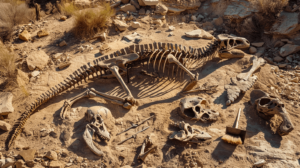
Delving into metabolic insights, studies suggest that velociraptors likely maintained a high metabolism, akin to modern birds, due to their agile hunting behaviors. This high metabolic rate, indicative of a warm-blooded creature, enabled Velociraptors to pursue prey actively and efficiently. The presence of feathers, inferred from fossilized quill knobs, not only supports the notion of their high metabolism but also hints at a pivotal system for regulating body temperature. These adaptations suggest that Velociraptors led an active lifestyle, necessitating a constant and high energy output.
To convey a deeper meaning for the audience, consider the following points:
Through these adaptations, Velociraptors were not just survivors but thrived by being well-adapted to their environment, showcasing an evolutionary link to the birds we see today.
Despite their formidable reputation, velociraptors weren’t immune to the ailments that plague living creatures, evidenced by fossils showing signs of disease and injury. These prehistoric predators faced a range of health issues, from healed injuries to arthritis, highlighting their resilience and the harsh conditions of their existence.
Healed injuries in velociraptor fossils suggest they could survive serious wounds, likely sustained during hunting or conflicts. Such findings provide a glimpse into their tough lives and their ability to recover, underscoring the survival of the fittest in the prehistoric world. Additionally, some specimens show signs of arthritis and other joint issues, indicating that like many creatures today, velociraptors weren’t strangers to the aches and pains that come with age or injury.
Parasites, including tapeworms, have been identified in velociraptor coprolites (fossilized feces), offering insights into the diet and health of these dinosaurs. These discoveries reveal that velociraptors contended with internal foes, such as parasites, which could impact their health and survival.
Furthermore, the discovery of fossilized remains with tumors suggests that velociraptors could suffer from cancer, a disease not exclusive to modern beings. This finding challenges the perception of prehistoric life and health, showing that dinosaurs faced similar health issues as contemporary animals.
Studies on bone abnormalities have shed light on velociraptors’ growth and development, revealing how diseases and injuries could affect their physical condition and potentially their lifespan. Such research enriches our understanding of velociraptor biology and the evolutionary pressures that shaped these fascinating creatures.
The Velociraptor’s habitat spanned across what is now known as Mongolia and parts of China, thriving in the diverse environments of the Late Cretaceous period. These predators adapted to the arid conditions of the Gobi Desert, suggesting they were versatile hunters capable of surviving in harsh climates. Their ancient geographic distribution and environmental conditions offer insights into their survival strategies and ecological roles.
Velociraptors, commonly known for their fearsome reputation, originally roamed the arid deserts of Asia, particularly within the Djadochta Formation in Mongolia. These remarkable creatures showcased a high degree of adaptability, thriving in the challenging conditions of the Gobi Desert during the Cretaceous period. Their habitat offered an abundance of prey, from lizards to dinosaur eggs, underscoring their versatility as hunters.
Key aspects of Velociraptor’s ancient geographic distribution include:
Exploring the diverse environments of their era, Velociraptors thrived in what is now known as the Gobi Desert, adapting to various challenging conditions. During the Late Cretaceous epoch, approximately 75-71 million years ago, these agile predators roamed the landscapes of Asia, leaving behind fossils that provide insight into their lives. The Djadochta Formation in Mongolia and the Bayan Mandahu Formation in China have been instrumental in uncovering the existence of different Velociraptor species. These sites reveal that Velociraptors were not confined to a single habitat but were adaptable to the changing environments they encountered. The varied and adaptable environments of the Gobi Desert offered a perfect backdrop for the Velociraptor species to evolve and thrive.
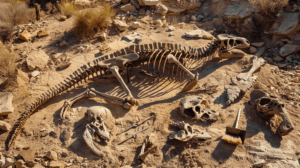
Fossils of the Velociraptor, discovered in various formations across the Mongolian desert, have revolutionized our understanding of this Late Cretaceous predator. The meticulous excavation and study of Velociraptor fossils in Mongolia’s Djadochta Formation, Barun Goyot Formation, and Bayan Mandahu Formation have provided unparalleled insights into the anatomy and behavior of these creatures, highlighting their adaptation to desert environments. These fossil discoveries underscore the Velociraptor’s role in its ecosystem and its evolutionary journey.
The importance of these discoveries can be summarized as follows:
These fossil discoveries have not only enriched our knowledge of Velociraptor’s life during the Late Cretaceous period but also contributed to a broader understanding of the prehistoric world, illustrating the dynamic interactions between predator, prey, and environment in ancient ecosystems.
The Jurassic Park movie franchise catapulted Velociraptor to fame, fundamentally reshaping its image in the eyes of the public. Before its silver screen debut, Velociraptor was known primarily to paleontologists and dinosaur enthusiasts. However, its portrayal as an intelligent, cunning predator in these films has made it an iconic figure in popular culture. The movies often showcase Velociraptors as pack hunters, working together with almost military precision to outsmart their prey—and sometimes, their human counterparts. This representation, while thrilling, isn’t completely accurate; the debate on their pack behavior remains unresolved in the scientific community.
Moreover, the Jurassic Park series, along with other media depictions, exaggerates the size of Velociraptors. In reality, they were much smaller than portrayed, standing just about as tall as an average human’s waist. Despite these discrepancies, the portrayal of Velociraptors in media has sparked a widespread fascination with these ancient creatures. Their depiction as smart and social beings has led to a deeper public interest in dinosaur behavior and intelligence, encouraging more people to explore paleontology and the study of prehistoric life.
As Velociraptors continue to feature in films, TV shows, and books, their role as a symbol of prehistoric cunning and survival only grows stronger. These portrayals, while not always scientifically accurate, have cemented Velociraptors’ status in popular culture, making them one of the most recognizable dinosaurs to people around the globe.
People often ask for fascinating facts about velociraptors, and there’s plenty to share. To begin with, they weren’t the towering monsters movies depict; they were actually about the size of a turkey. Additionally, they sported feathers, challenging our traditional view of dinosaurs. Finally, evidence suggests these cunning predators might have hunted in packs, making them even more formidable. These insights not only intrigue but also deepen our understanding of these ancient creatures.
You might think velociraptors tapping their claws is just a Hollywood invention, but it’s a real behavior. They do it to keep their claws sharp and clean, essential for hunting. This action isn’t just about maintenance; it also plays a role in communication. By tapping, they may signal dominance or readiness to peers, adding an intriguing layer to their social dynamics. It’s a distinctive trait, highlighting their complex nature.
The question at hand explores why the Velociraptor went extinct, a mystery intriguing many. Experts believe they vanished around 75 million years ago during the Late Cretaceous period. Factors like climate change, competition, and possibly an asteroid impact could’ve contributed to their demise. Environmental changes, shifts in food sources, or natural disasters likely played roles, suggesting their extinction was part of a larger event that affected numerous species at the time.
The question delves into the distinction between a Velociraptor and a raptor. Essentially, Velociraptor is a specific genus within the broader raptor category, which encompasses various dromaeosaurid dinosaurs. Unlike the general term ‘raptor’ that refers to a wider group, including species like Deinonychus and Utahraptor, Velociraptor is known for its unique size, traits, and behaviors, making it a distinct and well-studied member of the raptor family.
When comparing sizes, a person would find themselves eye to eye with a Velociraptor, as both reach about 1.8 meters (6 feet) in length. However, with a weight of around 45 kg (100 pounds), these ancient predators were lighter, reflecting their agile nature. Despite their similar height to humans, Velociraptors’ distinct body structure made them formidable hunters, especially adept at pursuing smaller prey. Their size and agility highlight their predatory efficiency.
When comparing prehistoric creatures to modern-day animals, it’s fascinating to note their sizes. For instance, a creature that roamed the earth during the Cretaceous period stood only 0.5 meters (1.6 feet) tall at the hip. Despite its small stature, it was an agile and efficient hunter, characteristics that contributed to its survival in a world of giants. This creature’s compact size allowed for remarkable speed and maneuverability, making it a formidable predator in its time.
They were turkey-sized, measuring about 1.8 meters long and weighing roughly 45 kg. Their bodies were likely covered in feathers, similar to modern birds, with long feathers on their arms indicated by quill knobs on fossils. Despite having wing-like arms, they couldn’t fly due to insufficient wing shape and size. They had large, sickle-shaped retractable claws on each foot, sharp serrated teeth, and were incredibly agile, capable of speeds up to 24 miles per hour.